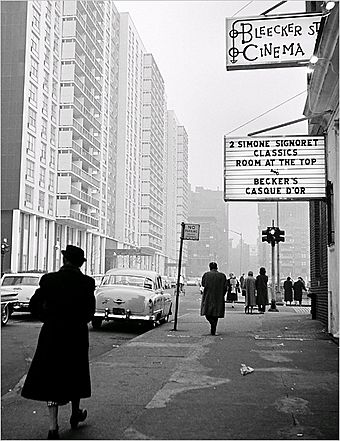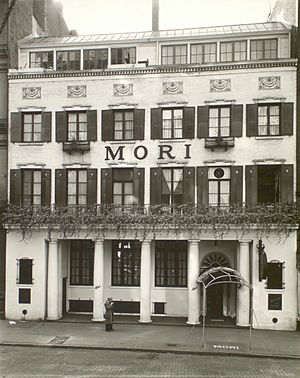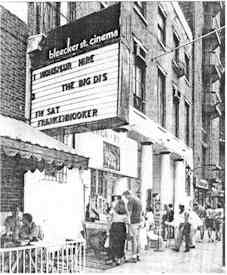Bleecker Street Cinema facts for kids

Bleecker Street Cinema, looking east.
|
|
| Former names | Mori (1883–1937) Montparnasse |
|---|---|
| Address | 144 Bleecker Street New York City, New York |
| Location | 144 Bleecker Street Manhattan, New York City, New York |
| Owner | Placido Mori, New York University, Lionel Rogosin, Sid Geffen, Jackie Raynal, John Souto |
| Type | restaurant, art house movie theatre |
| Capacity | 200 |
| Construction | |
| Built | 1832 |
| Opened | 1883 |
| Renovated | 1883, 1960 |
| Closed | September 2, 1991 |
| Architect | Raymond Hood |
The Bleecker Street Cinema was a special movie theater in Manhattan, New York City, New York. It was known for showing unique films, often called art house or independent films. These were movies that weren't always big Hollywood blockbusters. The cinema became a famous spot in Greenwich Village. It was a favorite place for filmmakers and movie lovers. The Bleecker Street Cinema closed in 1990. It reopened for a short time, showing art films again, but then closed for good in 1991.
Contents
A Look Back at the Bleecker Street Cinema
From Restaurant to Movie House
The building at 144 Bleecker Street has a long history. It was built in 1832 as two rowhouses. These are houses built in a row, sharing side walls. In 1883, a man named Placido Mori turned one of them into a restaurant called Mori.
A famous architect named Raymond Hood helped design the restaurant's new look. This was around 1920. He added cool Doric columns to the front. He also put special Federal-style decorations above the windows.
Mori restaurant closed its doors in 1937. The building was empty for a while. Then, in 1944, some political groups used it as their headquarters. Later, it became another restaurant called Montparnasse. By 1959, New York University owned the building.
A Hub for Independent Films
In 1960, filmmaker Lionel Rogosin opened the Bleecker Street Cinema. He wanted a place to show his film Come Back, Africa. This movie was important because it showed life in South Africa. The cinema had 200 seats for moviegoers.
In the early 1960s, a group of independent filmmakers used the cinema. They showed their experimental movies late at night. Soon, the Bleecker Street Cinema became very popular. Film critic James Hoberman called it one of New York City's top movie houses. It was a place where people could see older, classic films.
The cinema even had a house cat named Breathless! The cat was named after a famous French movie. Sometimes, Breathless would climb onto the movie screen during a show. When the cinema closed in 1990, its last cat was named Wim. This was a tribute to director Wim Wenders.
Sid Geffen bought the theater around 1973 or 1974. He ran it with his wife, Jackie Raynal. They also owned another cinema, the Carnegie Hall Cinema. Many people who became famous in the film world started their careers here. This included Bingham Ray and Bruce Goldstein.
The Cinema's Final Years
Sid Geffen passed away in 1986. His wife, Jackie Raynal-Sarré, faced challenges keeping the cinema open. She said that the rent for the building became too high. It was more than the theater could afford to pay. The cinema had a main room with 171 seats. It also had a smaller room, the James Agee Room, with 78 seats.
The Bleecker Street Cinema closed on September 6, 1990. The last film shown was Ariel. The very last film to finish was Jesus of Montreal. The James Agee Room's last movie was Fun Down There.
The cinema reopened briefly after that. It showed art films again for a short time. But it closed for good on September 2, 1991. The final movies shown were Jimi Hendrix at the Isle of Wight, Shadows in the City, and Suckling.
Why the Bleecker Street Cinema Mattered
The Bleecker Street Cinema was very important for movies. It showed many foreign and independent films. This helped inspire new filmmakers. It also taught film historians and critics a lot about cinema.
One historian said that people like Sid Geffen made a big difference. Their choices of what movies to show helped shape film history. The Bleecker Street Cinema was a key place for film lovers in New York City.
The Bleecker Street Cinema in Movies
The Bleecker Street Cinema even appeared in some movies!
- In Desperately Seeking Susan (1985), some scenes were filmed there. One character worked as a projectionist at the cinema.
- In Woody Allen's 1989 film Crimes and Misdemeanors, a character visits the cinema. He goes to see Mr. and Mrs. Smith and Happy Go Lucky.
- The cinema also appeared in the movie The Prince of Tides.



